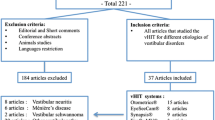Abstract
Objective
To compare the performances among three different systems for video head impulse test (vHIT), and to identify an optimal target angle for precisely evaluating the function of vertical semicircular canals in vHIT.
Methods
A two-center prospective study was done. Participants were sit 1.2 m away from the wall in a noise-proved room that dedicated for vHIT experiments. During the comparison experiments, similar settings were ensured in both hospitals, with the same distance to wall and angle of staring. For each equipment, the procedures followed the developers’ recommendations. The same examiner performed the comparison between two systems in one location. For the eye-position projects, targets were placed on the wall sequentially at the pre-marked lines for different angles. For the comparison projects, 9 and 13 participants were recruited, respectively. Any participant with otologic or vestibular disorders was excluded. A total of 26 healthy participants were recruited in the eye-position experiments, 16 of which were further involved in inter-examiner tests.
Results
Our evaluations of three different systems showed that a new vHIT system, VertiGoggles® ZT-VNG-I (VG) performed as good as the long-tested Otometrics® ICS impulse (Oto) and EyeSeeCam® (ESC). During the comparison, we validated 25-degree, instead of right ahead at 0 degree, is a better place to set the targets when torsion was applied at vertical semicircular canal planes.
Conclusion
The new VG system is good for clinical practices. Furthermore, we proposed a new protocol to set the targets 25 degrees from right ahead after tilting head 45 degrees to evaluate vertical canals during vHIT.
Similar content being viewed by others
References
Abrahamsen ER, Christensen AE, Hougaard DD. Intra- and Interexaminer Variability of Two Separate Video Head Impulse Test Systems Assessing All Six Semicircular Canals. Otol Neurotol, 2018,39(2):e113–e22
Neuhauser HK, von Brevern M, Radtke A, et al. Epidemiology of vestibular vertigo: a neurotologic survey of the general population. Neurology, 2005,65(6):898–904
Jiang T, Kindt K, Wu DK. Transcription factor Emx2 controls stereociliary bundle orientation of sensory hair cells. Elife, 2017,6:e23661
Bárány R. Über die vom ohrlabyrinth ausgelöste gegenrollung der augen bei normalhörenden. Arch Ohren Nasen Kehlkopfheilkd, 1906,68:1–30
Bárány R. Untersuchungen über den vom vestibularapparat des ohres reflektorisch ausgelösten rhytmischen nystagmus und seine begleiterscheinungen. (Ein Beitrag zur Physiologie und Pathologie des Bogengangapparates). Monatsschr Ohrenheilkd, 1906, 40:193–297
Henriksson NG. An Electrical Method for Registration and Analysis of the Movements of the Eyes in Nystagmus. Acta Oto-Laryngologica, 1955,45(1):25–41
Bárány R. Physiologie und pathologie (funktionsprüfung) des bogengang-apparates beim menschen: klinische studien. ranz-Deuticke-Verlag, Leipzig. 1907.
Halmagyi GM, Curthoys IS. A clinical sign of canal paresis. Arch Neurol, 1988,45(7):737–739
Alhabib SF, Saliba I. Video head impulse test: a review of the literature. Eur Arch Otorhinolaryngol, 2017, 274(3):1215–1222
Halmagyi GM, Chen L, MacDougall HG, et al. The Video Head Impulse Test. Front Neurol, 2017,8:258
Migliaccio AA, Cremer PD. The 2D modified head impulse test: A 2D technique for measuring function in all six semi-circular canals. J Vestib Res, 2011,21(4):227–234
McGarvie LA, Martinez-Lopez M, Burgess AM, et al. Horizontal Eye Position Affects Measured Vertical VOR Gain on the Video Head Impulse Test. Front Neurol, 2015,6:58
Thurtell M, MacDougall HG, McGarvie LA, et al. The Video Head Impulse Test (vHIT) Detects Vertical Semicircular Canal Dysfunction. PLoS One, 2013,8(4):e61488
Castro P, Sena Esteves S, Lerchundi F, et al. Viewing Target Distance Influences the Vestibulo-Ocular Reflex Gain when Assessed Using the Video Head Impulse Test. Audiol Neurotol, 2018,23(5):285–289
Judge PD, Rodriguez AI, Barin K, et al. Impact of Target Distance, Target Size, and Visual Acuity on the Video Head Impulse Test. Otolaryngol Head Neck Surg, 2018,159(4):739–742
Author information
Authors and Affiliations
Corresponding authors
Ethics declarations
The authors have no funding, financial and non-financial relationships, or conflicts of interest to disclose. This manuscript is approved by all authors for publication.
Additional information
This work was supported by grants from the National Science Foundation for Outstanding Young People (No. 81922018), the Transformation and Industrialization of Scientific and Technological Achievements in Shanghai (No. 18441904000), the National Natural Science Foundation of China (No. 81771011), the National Natural Science Foundation of China Young Investigator Program (No. 81800907), the Development Fund for Shanghai Talents (No. 2017046), and the Excellent Personnel Training Plan for the Shanghai Health System (No. 2017Q003).
Electronic supplementary material
Rights and permissions
About this article
Cite this article
Jiang, T., Li, F., Yu, J. et al. Evaluation on Effectiveness of a New System as well as Analysis on Optimal Horizontal Eye Position for Vertical Video Head Impulse Test. CURR MED SCI 41, 705–711 (2021). https://doi.org/10.1007/s11596-021-2415-1
Received:
Accepted:
Published:
Issue Date:
DOI: https://doi.org/10.1007/s11596-021-2415-1




